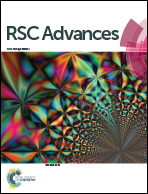Two new photochromic coordination compounds with nonphotochromic ligands and different metal centers†
Abstract
Recent research has demonstrated the effective synthesis of photochromic coordination compounds via the assembly of nonphotochromic ligands (electronic donors and acceptors) and a metal center (joint points). To enrich this system, the metal center could be expanded to binuclear or multinuclear, but related studies are rare. Two new photochromic coordination compounds with different metal joint dots were obtained using expanded metal centers. In this work, [Zn2(Bpy)1.5(CTA)4·2H2O] (1, CTA = crotonic acid, Bpy = 4,4′-bipyridine) and [Zn2(Bpy)(CTA)4] (2) were synthesized under different pH conditions. Compound 1 features a 1-D chain structure with 4,4′-bipyridine coordinating to mono zinc ions and binuclear Zn units simultaneously. Compound 2 also features a 1-D chain structure, where only the binuclear Zn is bridged by the 4,4′-bipyridine. This work will help to obtain new and promising photochromic compounds with different multinuclear metal centers and high performance.



 Please wait while we load your content...
Please wait while we load your content...